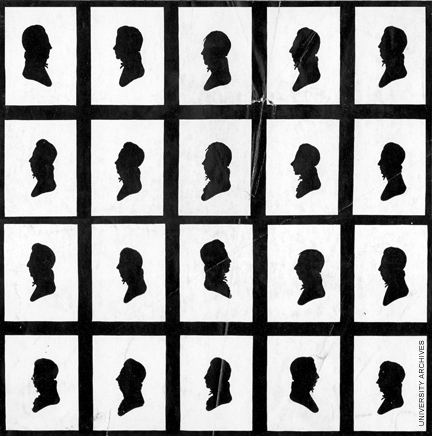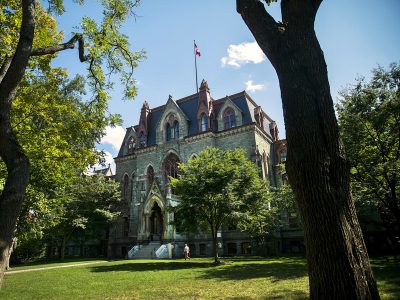
Two centuries ago a score of young men processed from the College’s Ninth Street campus to the Independent Tabernacle on Fourth Street. The occasion was Penn’s Commencement.
Showing off their oratory skills, Samuel Blanchard How C1811 spoke ironically (according to contemporary accounts) in “defence of dueling,” while his classmates waxed on about ambition, the pleasures of rural life, the immortality of the soul, and the education of women.
We don’t know how much pomp and circumstance the graduates put into the occasion (though Trustees minutes show that collegiate gowns were in use by 1813). But at some point before Commencement, these young men visited Charles Willson Peale’s nearby museum and had their silhouettes, or “profiles,” made.
A set of those silhouettes, once owned by Benjamin Gratz C1811, can be found at the University Archives and Records Center. To flesh out those images, the Archives has posted an online exhibit on the Class of 1811, offering a glimpse of the College (or “Philosophical School,” as it was once called) in the early 19th century as well as of the graduates’ post-Penn lives.
A popular attraction for Penn students, Peale’s museum housed a trove of natural specimens and curiosities meant to enlighten the curious masses. For a few cents above the 25-cent price of admission, visitors could have their profiles made by a physiognotrace machine. According to David Brigham, author of Public Culture in the Early Republic: Peale’s Museum and Its Audience, friends and family members often exchanged silhouettes from the museum with one another and sometimes mounted them in albums.
“I don’t think you can say these are class pictures as we think of them, but they clearly demonstrate the urge to have a keepsake image of friends and fellow college students,” says Mary McConaghy, the Penn Archives historian who prepared the Class of 1811 exhibit. (Later classes documented themselves in handwritten classbooks. Printed yearbooks were created at Penn in 1863, and individual class photos appeared in 1888.)
According to Brigham, Peale subscribed to the theories of Swiss scientist Johann Kaspar Lavater, linking physical features with character. While the 21st-century viewer is unlikely to read so much into the pointy nose of one graduate or the swallowed chin of another, we do have some actual life histories to refer to. Here are a few:
Isaac C. Snowden, C1811 M1814
As resident physician of the Philadelphia Almshouse, Snowden was the first American to publish an essay on delirium tremens in 1815. His writing shed light on the disease of alcohol addiction, which had once been viewed as a form of mania.
In choosing to be a doctor, Snowden followed the path of the typical 1811 Penn graduate. Medicine, clergy, and the law were among the few occupations for which a degree made financial sense at that time, according to McConaghy.
But in later years Snowden broadened his practice, seeking a cure for the mediocrity he saw in American letters. In 1827 he founded the Philadelphia Monthly Magazine as his remedy. The literary and fine-arts publication, which he edited for a year before his death from tuberculosis at 37, featured articles about the language of the Chippewyans and the pyramids of Egypt, anecdotes of Samuel Johnson, a report on an “African Fancy Ball,” and poetry about the Iroquois’ “Spirit of War.”
Benjamin Gratz C1811
Like many of his classmates, Benjamin Gratz came from a prominent local family. His father, Michael, was a German-Jewish immigrant who had made his name in Philadelphia as a merchant. His brother Simon helped found the Pennsylvania Academy of Fine Arts, and his sister Rebecca, a noted philanthropist, supposedly inspired the heroine Rebecca in Sir Walter Scott’s Ivanhoe.
After serving as a second lieutenant in the War of 1812, Benjamin Gratz made a name for himself in Kentucky, where he became a hemp manufacturer, helped develop the first railroad of the west, and served as a trustee of Transylvania University. He also supported an orphan asylum and distributed medicine to the poor when cholera struck Lexington.
Gratz’s hospitality earned several prominent visitors to his home, including the Marquis de Lafayette, Thomas Hart Benton, and Henry Clay. Though a slave owner himself, Gratz was an ardent Union supporter, offering his home as a commissary and cookhouse for troops during the Civil War.
The war brought particular grief to Gratz’s family, however. His son Cary was killed while fighting for the Union at the Battle of Wilson Creek in Missouri; less than half a mile away, his stepson, Joseph Shelby, fought for the Confederates. Shelby went on to lead his Iron Brigade on a 1,500-mile raid, attacking 10 Union forts and killing, capturing, or wounding more than a thousand Union soldiers.
In a resolution upon his death in 1884, the Kentucky A&M College lauded Gratz as an “enlightened patriot, [a] benevolent and eminently just and upright citizen.”
Samuel Blanchard How C1811
Samuel Blanchard How’s pro-dueling Commencement speech suggests a taste for irony, but there was no irony in the tract he wrote decades later, as a theologian defending slaveholders in Southern churches.
“The desire and attempt to deprive others of property which the law of God and the law of the land have made it lawful for them to hold, is to strike a blow at the very existence of civilization and Christianity,” How wrote in Slaveholding Not Sinful. Slavery, The Punishment of Man’s Sin, Its Remedy, The Gospel of Christin 1856. Though How believed slavery was “an evil much to be lamented,” he thought God allowed it to exist as a punishment for human sin.
After serving as president of Dickinson College from 1830 to 1833, How left to become pastor of a Reformed Dutch Church in New Brunswick for several decades.
George Duffield C1811 Hon1841
George Duffield also found his calling as a pastor, but during his life he cultivated interests in a wide range of worldly matters, from the development of railroads to bettering conditions in insane asylums, though the only ones he supported from the pulpit, such as the temperance movement, bore his stamp of scriptural authority.
According to the Encyclopedia Dickinsonia of Dickinson College (where he became a trustee in 1820), Duffield also earned his share of enemies for his support of “the more active and emotional doctrines” of “new light” Presbyterianism. The views he expressed on moral reform and other topics in his 1832 book, Spiritual Life, or Regeneration, led to heresy charges that forced him out of the pulpit of his church in Carlisle, Pennsylvania.
Duffield remained at his next church in Detroit for 30 years and served as a regent at the University of Michigan. In that city he encountered another faction who pushed for him to step down—this time, unsuccessfully. According to an account of his diaries in the Mississippi Valley Historical Review, “For years afterward, he would regard any death in those members’ families as an act of providential punishment.”
Early Days at Penn
When the members of the Class of 1811 matriculated in 1808, the Philosophical School, as the College was then called, had only 31 students. A year before they graduated, the University was reorganized into three parts: the Charity Schools and the Academy, on Fourth Street; and the College—including the medical, law, and collegiate departments—on Ninth Street. (It took the law program a while to get off the ground; the first Penn law degree wasn’t awarded until 1852.)
Six professors taught the bulk of the curriculum—natural philosophy (sciences); moral philosophy (ethics, history, logic, economics, and politics); Latin and Greek; German and Oriental languages; mathematics; and oratory and English literature. During this time Penn’s instructors had to deal with other constraints, such as “the trustees trying to manage what happened in the classrooms at a micro-level,” says Mary McConaghy, the Archives historian who created the Class of 1811 exhibition. “It was a hard time to be a college professor.”
According to McConaghy, College students lived at home with their families or in “respectable boardinghouses” off campus. She did find at least one hint of life outside the classroom, however. To mark Washington’s birthday in 1811, one student presented a speech to an organization called the Hermean Society. Although that group’s purpose is unknown, McConaghy notes that another, still-surviving organization, the Philomathean Society, was created just four years later.
The average member of the Class of 1811 was 19 years old at graduation; the youngest was just 15. To attract students and meet expenses, McConaghy explains that colleges “sometimes even made it possible for students to get their degrees in two years rather than the then-customary three years of attendance.” In addition, “several classes in the first decade of the 19th century were allowed to skip their last year in the Academy to proceed directly into the College …”
In preparing the exhibit, she notes, “the most interesting things I learned relate to the wider trends in higher education at the time. I had known that the College had trouble attracting and keeping students during the early 19th century; it was interesting to see that part of the reason was the overabundance of new colleges that sprung up in the wake of the American Revolution—all based on the idea that a democratic citizenry needs to be educated.”
—Susan Frith




